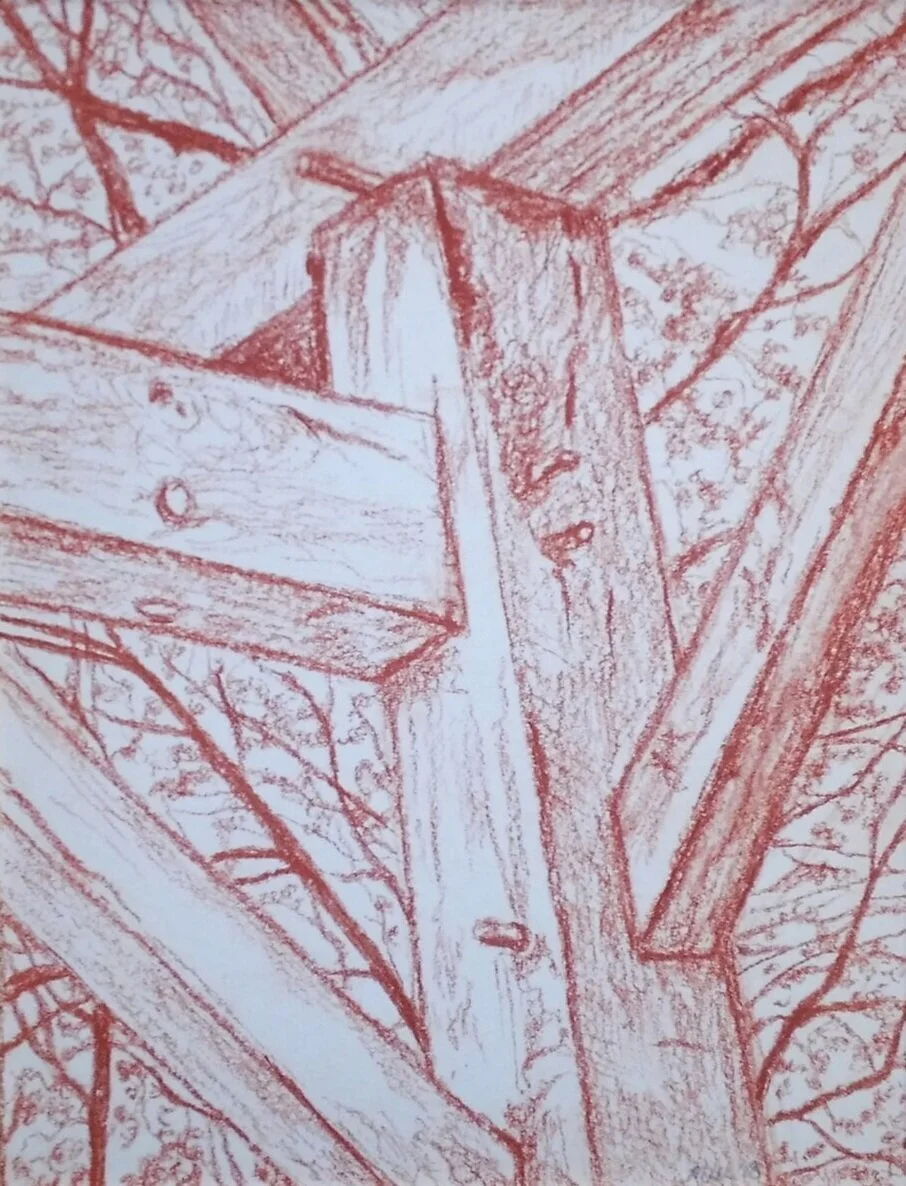The Whole Field • Volume 2 • No. 2 • Super New Moon • January 21st, 2023
“Corner Brace”
Conté Crayon • 7” x 10” • Malaika Whitney of Whitney Farmstead
In This Issue: Resourcefulness, Lagoon Crawlers, and Deep Bedding.
Danu Hof: A Virtual Twilight Tour
Curious about farming in Northern Michigan? Click the video above to join Caitlin and Larry of Danu Hof Farm & Market for a winter tour. As Microloan recipients, members of Crosshatch’s first Carbon Farming Cohort, and the catalysts behind the Bellaire farm-to-food truck operation “The Skep,” you’re in good hands.
The Warp — Ideas and Inspiration
|| 1 || Caitlin shares about resourcefulness when seeking out materials and tools for farming—consider pickle buckets, non-working fridges, restaurant containers and more. These materials that likely would have been relegated to the waste stream can find homes in small-scale food systems. More than just being adequately functional, as she shares, some of them fulfill their purpose much better than their store-bought counterparts. If a food-grade plastic barrel, cut-in-two, can withstand the rigors of a seven-hundred lb. Duroc sow like Penelope better than a fairly-costly, mass-market hog feeder, the ingenuity is worth it.
|| 2 || Speaking of costs, I came across a used vehicle for sale in our area online. A mere $150,000. It piqued my interest—a red tank looking thing, and it had a cannon. I wanted to know more, so I spent a few minutes internet sleuthing.
It was a lagoon crawler. I saw highlight videos of the massive, remotely-operated, amphibious vehicle swimming and spraying through poo-ponds. Its purpose is to agitate the giant pits of manure at CAFO’s (concentrated animal feeding operations,) ensuring that solids and liquids are evenly mixed into a slurry that can be applied to fields. It can float side to side, forwards and back, and all around, and has seven agitation jets, capable of pumping 12,000 gallons of slurry per minute. Yes, minute. That’s a boatload of manure.
Those ponds negatively effect the people who live and work around them, even amidst legislature aimed at minimizing their impact and protocol designed to keep farm workers safer. A quick perusal of the Wikipedia entry for manure lagoons offers myriad rabbit-trails and studies, and they all seem to say the same thing—proximity to a manure lagoon is dangerous in terms of human health and broader ecological health. Think elevated asthma rates, surface-water eutrophication and acidification, and increased toxins, pathogens, etc, in groundwater. There’s a cost to systems prone to periodic spillage and constant air pollution, especially during agitation.
This isn’t representative of land and waste management at all farms. Danu Hof utilizes the practice of deep bedding—periodically adding straw and organic material to beds and turning layers when called for. This allows for more carbon content mixed in with manure, which aids in decomposition. It even produces an amount of heat under hoof, a consideration for cold-climate animal husbandry. In short, animal “waste,” something toxic and problematic in concentrated slurries, especially in large volumes, can serve an important role in on-farm nutrient cycling. Good stewardship ensures that it breaks down efficiently and supports soil health and ecological patterns, rather than endangering them.
The Weft — News and Events
|| 1 || The 2023 Food and Farm Microloan Application window is now open. Applications are due February 7th. More information is available here.
|| 2 || Are you a farmer, rancher or forest manager? Share your vital feedback with USDA by taking a nationwide survey here. The survey is completely anonymous, will take about 10 minutes to complete, is available in multiple languages, and will be open until March 31, 2023. Also note, 2022 USDA Census of Agriculture responses are due February 6th. To find out more about the five-year questionnaire, visit the USDA’s Census of Agriculture page.
|| 3 || If you are a farmer, or work with an organization that works with farmers, here’s an opportunity for small, short-term grants aimed at mental health and stress efforts in agriculture. Farmers can apply for this funding directly to support stress work with their employees. If you caught Remington Rice’s Small Farm Conference presentation, you know how important this work can be. Learn more here.
Many thanks to the Michigan Arts & Culture Council and the National Endowment for the Arts for their support of this work.
Copyright (C) 2023 Crosshatch. All rights reserved.








